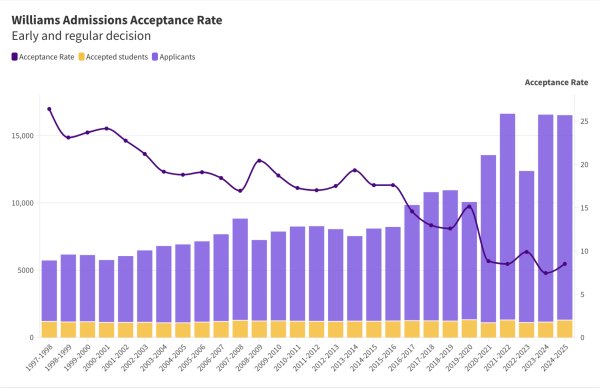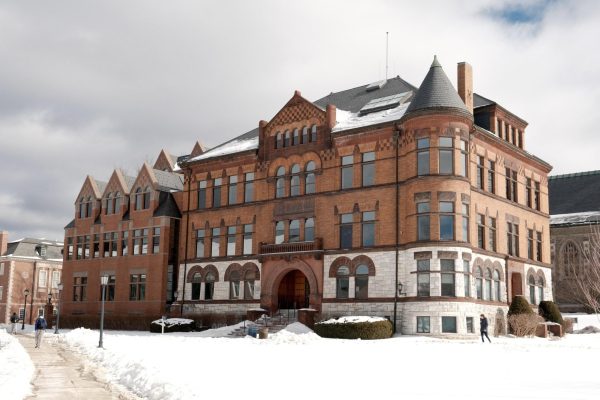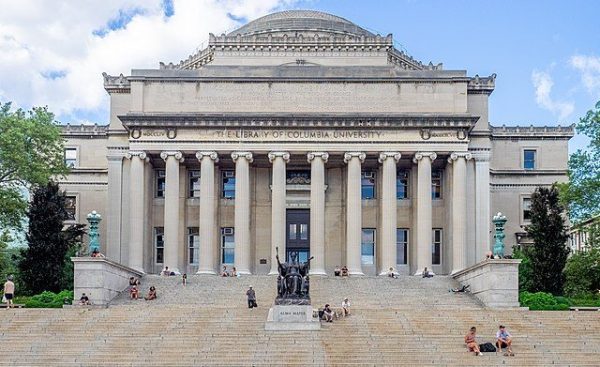College removes 127 students from campus in response to party
Administration defines involvement as any unauthorized presence at Wood that night; some Wood attendees say large parties were common in fall
On the night of Feb. 26, unmasked students were packed into the ground floor of Wood House, most of them non-residents of the building — violating the College’s COVID rules prohibiting indoor socializing. Many arrived expecting a smaller number of students, but they stayed nonetheless when more showed up. Throughout the night, informal invitations to friends and teammates led more students to join those who were already at Wood.
Upstairs, smaller gatherings were also occurring. Some of the students at those gatherings were unaware of the increasingly large group beneath them. As the crowd on the ground floor grew to 80 to 100 people, those present were seemingly unconcerned that Campus Safety and Security (CSS) might arrive and break up the party.
For many attendees, a fall semester with large indoor parties happening practically every weekend meant that this night at Wood House was nothing new.
This account of the party at Wood House is based on interviews with four students who were in the building the night of Feb. 26. They are referred to by pseudonyms and gender-neutral pronouns in this article.
Two of the students interviewed by the Record, “Morgan” and “Alex,” said they weren’t involved with the large party on the ground floor; they were at a smaller gathering in a secluded common room upstairs. Two other attendees — “Taylor” and “Charlie” — said they were at the large party. They had been spontaneously invited to smaller gatherings at Wood that then converged on the ground floor.
All four have since left campus after coming forward about their presence at Wood and then being told by the College to transition to remote learning, even though Morgan and Alex said they were not part of the large gathering. For the purposes of deciding whom to remove from campus, the College has defined involvement in the Wood party as unauthorized presence in the building — regardless of whether a student said they participated in the large party.
“Students who don’t live in Wood should not have been entering Wood for any reason on Friday night,” Dean of the College Marlene Sandstrom wrote in an email to the Record. “Unfortunately, those who did so during the time of the large gathering (even if that was not their intention when they walked over) contributed to that gathering, and are therefore part of the large scale public health violation.”
One hundred twenty-seven students in total have so far been removed from campus as part of the College’s response to the party at Wood. None of them have been subject to additional disciplinary action, and none of them are seniors. According to Sandstrom, around 12 to 15 students appealed their removal, but none were successful. Sandstrom also said that seven students have voluntarily left campus since the Wood party, with “an additional handful” of students currently making inquiries about doing so.
Director of CSS Dave Boyer told the Record yesterday that unless more students come forward with new information, CSS’ investigation into the party has concluded. CSS has interviewed 155 students, he said. He also said that any students who come forward in the future will, like those who have already come forward, likely be sent home without additional disciplinary consequences, though they will be evaluated on a “case-by-case basis.”
In the wake of the party, the response from the student body has largely focused on the role that athletic culture had to play. The two attendees of the large party that the Record spoke to said that the majority of those present were varsity athletes, but said that this was a function of the social networks to which athletes in team sports have access. Other students have pointed to a party culture among athletes, enabled by their disproportionate privilege, that has persisted during the pandemic.
The party, as told by those who were there
“It was a pretty typical Friday night,” Taylor said.
According to Taylor, many first-years socialize throughout Frosh Quad on weekend nights, though the sizes of those events are constrained by space limitations. “Through the grapevine, kids started hearing about a larger event at Wood House, and slowly kids would kind of drift [there],” Taylor recalled about that night.
Charlie also said that the large party came about organically. “It just so happened that in Wood that day there were a lot of different smaller, illicit gatherings going on,” they said. “And as the night went on, it kind of just merged into [a larger group].”
Taylor said they and about six other friends went to Wood between 11:30 and 11:45 p.m. “We really had no idea what to expect,” they said. Though the party began with “no more than 20 people or so” upstairs in a small room, Taylor said people began gravitating downstairs.
Taylor, who is on a varsity team, said that the majority of varsity athletes present at the party were members of team sports rather than sports that focus more on individual performance (like cross country or swimming).
“Given the COVID precautions on campus, it’s been really hard for a lot of freshmen that aren’t athletes to befriend sophomore and juniors,” they said. “Meanwhile, the athletes really have the ability to go out there and meet these older kids through practices, through lifts, through meetings.”
“The party was without a doubt on probably all three floors, kids in the hallway, kids in common rooms, kids on the staircase, all over the place,” they continued. “Definitely no masks, as described… I would definitely say the number was probably higher than 80 to 100.”
Charlie said that most students were crowded on the ground floor within a common room that had a beer pong table set up.
Taylor said they doubted that a single individual or group planned for an event of that size. “Once you have a solid group of 20 to 30 sophomores and juniors together, then the word gets out, and people slowly gravitate towards it,” they explained. “Even if you started with 15 of your friends, they would have had no chance of ever stopping it.”
CSS’ investigation also concluded that no one had intended for a party that large, Boyer told the Record. “I think it just happened that many people decided to do the same thing on the same night, which created a situation that was overwhelming for the house and the campus,” he said.
When a CSS officer arrived on the scene, students scattered immediately. “It didn’t seem like they had any intentions of trying to catch students,” Taylor recalled. “The CSS officer kind of walked in the middle of the room [and] stood there with their arms crossed.”
At the time, it did not seem like CSS was intent on tracking down any of the students present. “They were basically trying to break up the party and just had no intention of taking anyone’s IDs,” Taylor continued. “It was startling because they were just kind of there.”
A pattern of large indoor parties without enforcement
Those who were at the large party at Wood were not concerned that CSS would eventually show up, Taylor said. Throughout the fall, Taylor recalled, CSS broke up several large indoor parties, but the College didn’t respond to those gatherings by removing students who were there.
“It was never a personal question to me whether or not CSS is going to show up [at Wood that night]. It’s more of when is CSS going to show up,” Taylor said. “They set this precedent [last fall] that they take a student’s ID and maybe put them on probation or give them a strike, and then [the student would] kind of go on with themselves.” (In an interview with the Record, Sandstrom denied that the College has used a strike system for violations of its public health guidelines.)
Alex expressed their belief that this pattern of parties without enforcement had extended into the spring semester. They noted an indoor party the first weekend of the spring semester in their entry, which they said was broken up by CSS without resulting in any consequences for the party attendees.
Boyer said CSS investigated a few large gatherings in the fall, but those parties were not on the same scale as the Wood party. “It would depend on what the party was [and] what the circumstances were,” Boyer said. “It really depended what students told us, [and] whether they admitted to any violations or participation in a party.”
“We had that one outside party,” Boyer added, referring to an outdoor gathering of 120 students in September. “We had one other that I’m aware of that had maybe as many as 30 people there.”
CSS also reported a 50-person gathering at Wood House on Nov. 14 involving unmasked students and a “large group” in the basement, which resulted in an investigation to identify the students who participated.
Chief Communications Officer Jim Reische emphasized that there is a disconnect between what the administration and the student body is aware of. “What students know or say they know, and what we [in the administration] know often becomes different,” Reische said.
Upon arriving at Wood House on Feb. 26, Charlie was initially anxious about being present at such a large gathering but was reassured by their friends that the College had not enforced COVID guidelines in the fall.
“I was kind of freaking out the whole time,” Charlie said. “I was like, ‘Oh my God, what if CSS comes? What if I get COVID, because I’m also concerned about COVID?’”
“But the thing that everyone kept repeating was that — which is true — everyone in that building had tested negative, either on Thursday or Friday, every single person,” they continued. “So that was a reassuring thing. And the other thing is [my friends told me] this happened all the time last semester, every week, and CSS would come in, break up the party, and then leave and not take any names or anything.”
Even directly after the Feb. 26 party, Taylor said many students went to other gatherings from Wood, which they said went uninterrupted by CSS. Taylor also said they knew of students who went to socialize in off-campus houses that night.
Taylor recalled a party of “anywhere from 30 to 60 kids” at Tyler Annex at the beginning of the spring semester, as well as a party around Halloween with 40 to 50 attendees in Tyler House. “CSS walked in the doors,” Taylor said of the latter event. “Everybody ran, and one kid just took the heat and got his ID taken away. He got a strike and went on with it.”
Taylor’s account of a Halloween party last semester is corroborated by CSS reports; on the night of Oct. 31, CSS officers responded to a door malfunction alarm at Tyler House. An officer reported hearing at least 15 students “hastily make their way out of the back door and into the surrounding woods.”
Given what they saw as a pattern of illicit gatherings with little enforcement, those at the Wood party assumed that few consequences would follow if they were caught. “It wasn’t like anyone was really thinking that it was going to be blown to the proportions that we’re finding it today,” Taylor said. “Everyone, including myself, was just completely blindsided when President Mandel sent out this email that was taking the repercussions to a whole new level.”
President Maud S. Mandel told the Record that the College would have responded to large illicit gatherings in the fall if the administration had concrete information about them. “If it’s true that parties of this size and scope were happening all the time, we didn’t know about it,” Mandel said.
Sandstrom said no students had been transitioned to remote learning in response to a large gathering prior to the Wood party.
How the College decided who had to leave
Morgan and Alex, who are both first-years and varsity athletes, said they went to Wood House that night to attend a small gathering with their team. When they arrived at Wood, the house was mostly empty. Later on in the night, when they were told that a larger party was happening downstairs, they said they immediately left the building.
Morgan and Alex said that their team gathering at Wood was the first illicit gathering they had attended since arriving at Williams in the fall. “Last semester, we were never really remotely close to a party that was broken up by CSS,” Alex said.
Mandel’s email asked students who were “involved in organizing last night’s party” or “attended [the party] for any period of time” to come forward about their involvement. Since her email referred to a 80- to 100-person party at Wood, Morgan and Alex believed Mandel’s message wouldn’t apply to them.
“I was a little bit worried because I knew that I was in the building that night, but the way that the email was written was like if you were at the 80- to 100-person party,” Alex said. “So in my mind, it was like, we weren’t there.”
After talking with their team and coach, however, they both decided to disclose to the College that they had been in the building that night.
“[We had a] mentality shift from, ‘We weren’t at the party — this doesn’t include us,’ to ‘It doesn’t matter whether or not we were at the party,’” Morgan said. “‘We did something wrong.’ And we were wrong. We broke the rules. So we should come forward and be honest with the school.”
Given Mandel’s language, Alex said they were “confident” that the College would not send them home for coming forward about being in the building. Soon after providing a formal statement to CSS, however, they said Boyer informed them that the administration wasn’t differentiating between smaller gatherings and the larger party within the building.
“It was almost as if [the administration] didn’t care,” Alex said. “As long as the fact that you were in the building was in writing, that was enough to send you home.”
Sandstrom said that, though entering another residential building would usually not be a violation for which students could be sent home, those who were at Wood in any capacity that night contributed to the large gathering. “If you’re going to a place where you’re not supposed to go in, then it turns out that there’s a massively large, dangerous gathering, then you end up being part of that,” she said. “You’re part of the bodies of people who are making that an incredibly unsafe place.”
Sandstrom also noted that out of the students who came forward, more people claimed they were not participating in the party than physically possible, making it hard to differentiate between who was an active participant in the party and who was part of smaller gatherings in the building. “It just strained credulity,” she said.
Taylor said that every member of their sports team who was present at Wood House that night came forward. The morning after Taylor submitted their written statement to CSS, they received an email giving them 24 hours to leave campus.
Sandstrom said that the College offered rapid tests for COVID before students’ departures. “We would not allow any student who has tested positive, or who has been identified as a close contact to a known positive, to travel,” she said.
The College will refund 80 percent of board costs to students who transitioned to remote status last week, as per its refund policy.
Community expresses anger at party; Mandel urges ‘compassion’
Many members of the College community reacted with anger and frustration to the party once Mandel announced it in her initial email, as well as to Mandel’s subsequent email addressing the aftermath of the party.
Gwyn Chilcoat ’24 was one of many students who expressed anger about the party. “The judgment I would assign to such behavior … is that it is deeply irresponsible, privileged, and demonstrates utter disregard for their community’s health,” she said. “This doesn’t mean that these traits describe all athletes, or even those at the party, but those were the characteristics exhibited in the decision to attend and remain at such a gathering at this point in the pandemic.”
In the Facebook group “Williams Memes for sun-dappled tweens,” many students posted memes that mocked both Wood party attendees and the administration’s response.
For many of those at Wood on the night of the party, meanwhile, the harsh reaction from students, combined with the consequences imposed by the administration, made them feel that they were being maligned.
“We’ve already been tormented so much. We’ve realized how much of a stupid mistake it was,” Charlie, who is not an athlete, said of seeing social media posts about the party. “We’ve been sent home. I am at home right now. I’m not in college where I should be. I’m a student. And we’re still getting hate. Just chill out now.”
In her March 7 email, Mandel asked students expressing anger at partygoers to “extend compassion” and refrain from making personal attacks. “On social media some of you have descended into derision, stereotyping and stigmatization,” she wrote. “This must stop. The college has already imposed consequences. It is gratuitous and cruel to pile on.”
The email attracted criticism from some students who took to the Facebook meme group to say that it minimized the responsibility of party attendees and invalidated other students’ frustration at the party.
While Mandel’s message focused on vitriol targeted at students who had attended the large gathering, Taylor noted “aggressive” messages from partygoers toward the rest of the student body as well.
“Coming from an athlete, I was a little bit disappointed at some of the responses from athletes,” Taylor said. “It was just as aggressive from the athletes as it was from these people that were posting messages that were hateful towards the athletes.”
In an email to the Record, Mandel said her intent was not to invalidate students’ anger — anger which she said was “understandable.”
“I was asking students … not to stigmatize categories of students, many of whom did not attend the party at all,” Mandel said. She added that the students who attended the party “have already lost a great deal.”
“Perhaps we could recognize that the consequence of going to the party was already pretty severe and we didn’t need to add public shaming on top of everything else,” Mandel said.
Alexa Walkovitz ’21 spoke of their dissatisfaction with the administration’s call for compassion. “I felt alienated by it,” they said. “Because I’m like, ‘These are your rules you set. Why are you telling us to not be mad? You’re disappointed. We can’t be?’”
Correction: This article was updated at 6:51 p.m. on March 10 to reflect that the College will refund 80 percent of board costs to the students who have been removed from campus, which doesn’t include room costs as previously reported.
Kevin Yang ’22 is a political science and history major from Shanghai, China, and, before that, Stamford, CT. He is a senior writer. He has previously...
Annie Lu ’23 is a political science and mathematics major from San Diego, Calif. She is a senior writer. She previously served as the editor-in-chief...
Megan Lin ’24 is an art history and history major from Hartland, Wis. She is a managing editor and previously served as the executive editor for opinions,...







